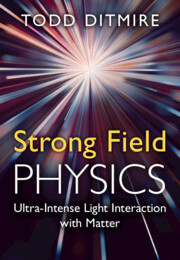Book contents
- Strong Field Physics
- Strong Field Physics
- Copyright page
- Contents
- Preface
- 1 Introduction to Strong Field Physics
- 2 Strong Field Generation by High-Intensity Lasers
- 3 Strong Field Interactions with Free Electrons
- 4 Strong Field Interactions with Single Atoms
- 5 Strong Field Interactions with Molecules
- 6 Strong Field Nonlinear Optics
- 7 Strong Field Interactions with Clusters
- 8 Strong Field Interactions with Underdense Plasmas
- 9 Strong Field Interactions with Overdense Plasmas
- Appendix List of Symbols
- Bibliography
- Index
6 - Strong Field Nonlinear Optics
Published online by Cambridge University Press: 05 July 2025
- Strong Field Physics
- Strong Field Physics
- Copyright page
- Contents
- Preface
- 1 Introduction to Strong Field Physics
- 2 Strong Field Generation by High-Intensity Lasers
- 3 Strong Field Interactions with Free Electrons
- 4 Strong Field Interactions with Single Atoms
- 5 Strong Field Interactions with Molecules
- 6 Strong Field Nonlinear Optics
- 7 Strong Field Interactions with Clusters
- 8 Strong Field Interactions with Underdense Plasmas
- 9 Strong Field Interactions with Overdense Plasmas
- Appendix List of Symbols
- Bibliography
- Index
Summary
Atoms subject to intense laser light will witness their bound electrons undergo nonlinear oscillatory motion and subsequent field-driven ionization. This nonlinear electron motion will reradiate electromagnatic waves at harmonic multiples of the laser frequency, often to high nonlinear orders. This chapter explores this high-order harmonic generation, considering the single-atom response combined with the coherent addition from many atoms leading to spatially coherent, short-wavelength radiation. After a phenomenological justification of high harmonics in which a quasi-classical three-step model is employed to describe harmonic generation from field-ionizing atoms, the chapter launches into a quantum description of the single-atom nonlinear dipole reponse using the strong field approximation. The following sections then address the effects of propagation and phase-matching through an extended media of nonlinearly driven atoms, assessing the effects of the geometric, intensity-dependent, and plasma-induced phase on the spatial coherence of the generated harmonics. The concluding section looks at the effect of attosecond pulse generation that accompanies harmonic production.
Keywords
Information
- Type
- Chapter
- Information
- Strong Field PhysicsUltra-Intense Light Interaction with Matter, pp. 316 - 389Publisher: Cambridge University PressPrint publication year: 2025
